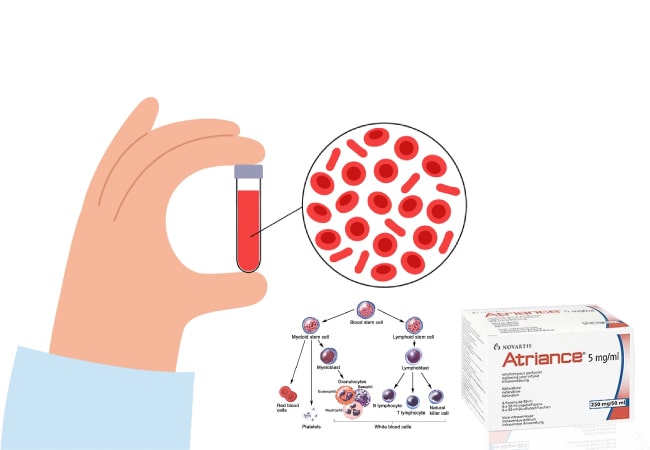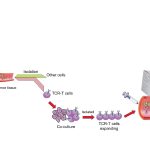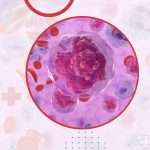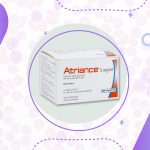Blood cancers, or hematologic cancers, encompass a variety of malignancies affecting the blood, bone marrow, and lymphatic system. Among these, T-cell acute lymphoblastic leukemia (T-ALL) and T-cell lymphoblastic lymphoma (T-LBL) are two distinct but closely related forms of cancer. Immature T-cells, a subset of white blood cells essential to immunological function, are the source of both disorders. Despite their similarities, they have key differences in origin, clinical presentation, treatment approaches, and prognosis. For the treatment of these blood cancers, Atriance injections are available which is common to both.
Origins and Cellular Characteristics:
T-Cell Acute Lymphoblastic Leukemia (T-ALL) is a fast-growing cancer of the blood and bone marrow. It primarily affects the immature T-cells, known as lymphoblasts, which proliferate uncontrollably in the bone marrow and bloodstream. This overproduction hampers the formation of healthy blood cells, leading to symptoms like anemia, infections, and bleeding due to a lack of red blood cells, white blood cells, and platelets, respectively.
T-cell lymphoblastic Lymphoma (T-LBL), on the other hand, is a type of non-Hodgkin lymphoma. It originates from immature T-cells but typically manifests as a mass in the thymus or lymph nodes rather than primarily affecting the blood and bone marrow. T-LBL can spread to the bone marrow and blood but predominantly forms solid tumors in lymphatic tissues and organs. In both these types of blood cancer, Atriance 250mg 50 ml has shown positive results.
Clinical Presentation:
The clinical symptoms of T-ALL and T-LBL can overlap but differ based on their primary sites of origin and spread.
- T-ALL often presents with systemic symptoms due to bone marrow infiltration. These include fatigue, pallor, frequent infections, fever, bruising, and bleeding. Patients may also experience bone pain and swelling of the liver or spleen due to the spread of leukemic cells.
- T-LBL typically presents with a large mediastinal mass, which can cause respiratory distress, chest pain, and superior vena cava syndrome. Other symptoms may include lymphadenopathy (swollen lymph nodes), hepatosplenomegaly (enlarged liver and spleen), and symptoms related to mass effect or compression of adjacent structures.
Diagnostic Approaches:
Diagnosis for both T-ALL and T-LBL involves a combination of clinical examination, imaging studies, and laboratory tests:
- T-ALL diagnosis relies heavily on blood tests showing high white blood cell counts with numerous lymphoblasts. Bone marrow tests are key for finding leukemia cells and identifying the exact type of leukemia. Doctors take samples of bone marrow and use special techniques to examine the cells closely. This helps them make an accurate diagnosis and plan the best treatment.
- T-LBL diagnosis often involves imaging studies like CT scans or PET scans to identify the location and extent of the lymphomatous masses. A biopsy of the afflicted lymph node or mass, followed by histopathological examination and immunophenotyping, confirms the diagnosis.
Treatment Strategies:
Treatment for T-ALL and T-LBL involves multi-agent chemotherapy regimens, with protocols similar in many respects but tailored to the disease’s specifics.
- T-ALL treatment typically includes induction chemotherapy to achieve remission, followed by consolidation and maintenance therapy to eradicate residual disease and prevent relapse. High-risk patients may require allogeneic stem cell transplantation.
- T-LBL treatment also starts with aggressive chemotherapy, often incorporating protocols used for lymphoblastic leukemia due to the disease’s aggressive nature.Doctors use radiation therapy to target specific areas with cancer or large tumors. This treatment focuses high-energy beams on the affected parts of the body to shrink or eliminate cancer cells in those locations. In some cases, stem cell transplantation is considered, especially for relapsed or refractory disease.
- Drugs and injections like Atriance 250 mg injections are given. Nelarabine is a cancer medication that requires a valid prescription from a doctor in order to be obtained. It is marketed under the brand name Atriance. Patients with T-cell lymphoblastic lymphoma (T-LBL) or T-cell acute lymphoblastic leukemia (T-ALL) who have relapsed or failed at least two rounds of chemotherapy are given Atriance (Nelarabine).
Prognosis:
The prognosis for both T-ALL and T-LBL has improved significantly with advances in treatment, but it varies based on several factors:
- T-ALL has a favorable prognosis in children, with long-term survival rates exceeding 80% with contemporary treatment protocols. Adult patients generally have a poorer prognosis, with survival rates around 40-50%, but outcomes are improving with new therapies and targeted treatments.
- T-LBL also has a good prognosis in children, with survival rates similar to T-ALL. In adults, the prognosis is less favorable but continues to improve with intensive chemotherapy and newer therapeutic approaches.
While T-ALL and T-LBL share a common origin in immature T-cells and have overlapping treatment approaches, they differ significantly in their clinical presentation, primary sites of involvement, and specific therapeutic strategies. As a part of the treatment, one can buy Atriance online as well from verified and legitimate suppliers against a valid prescription.
References:
https://www.businesswire.com/news/home/20220919005223/en/Seagen-Announces-TUKYSA%C2%AE-tucatinib-in-Combination-with-Trastuzumab-Granted-Priority-Review-by-FDA-for-Previously-Treated-HER2-Positive-Metastatic-Colorectal-Cancer
https://www.aacr.org/about-the-aacr/newsroom/news-releases/tucatinib-plus-trastuzumab-emtansine-may-benefit-patients-with-advanced-or-metastatic-her2-positive-breast-cancer/
Where can I buy Nelarabine online?
You can buy Nelarabine online through verified and trusted suppliers like the Indian Pharma Network (IPN). IPN facilitates the supply of genuine medicines globally. We facilitate access to FDA-approved medicines with a valid prescription. Contact us at Call/WhatsApp: +91 9310090915 for more details.
Is Nelarabine available in the UAE and other countries?
Yes, Nelarabine is available in the UAE and other countries, including Belgium, Qatar, Kenya, Nigeria, Saudi Arabia, South Africa, Singapore, the UK, and the USA. Contact us for legal access and delivery.
How can I buy Nelarabine from India?
To buy Nelarabine online from India, connect with us today. We specialize in sourcing and supplying FDA-approved medicines like Nelarabine. We ensure global delivery of Nelarabine to regions where it might not be readily available.
Who is a reliable Nelarabine exporter?
Indian Pharma Network (IPN) is a trusted Nelarabine exporter in India. We offer legal and reliable access to this medicine. We ensure compliance with global pharmaceutical standards and facilitate delivery to multiple countries worldwide.
Is Nelarabine approved and available in India?
Yes, Nelarabine is approved and available in India. It is marketed under the brand name Atriance and is used for treating T-cell acute lymphoblastic leukemia (T-ALL) and T-cell lymphoblastic lymphoma (T-LBL). Contact us today for legal access.






